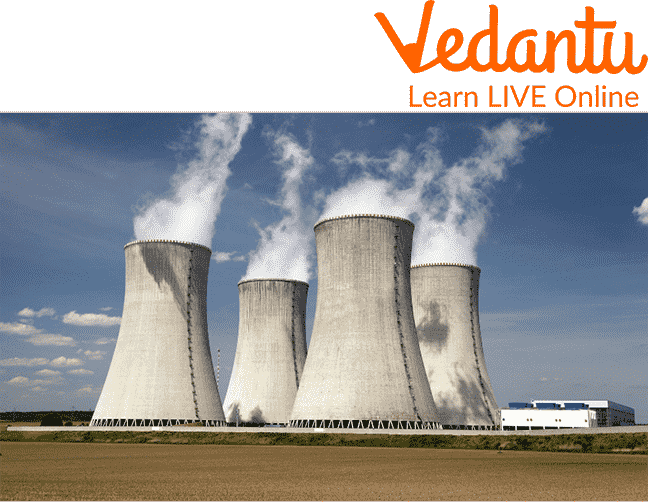




Overview of Nuclear Energy
Nuclear or atomic energy is the force that preserves the integrity of an atom's nucleus. The fundamental building blocks of matter are atoms. The core of an atom is its nucleus. Nuclear energy converts into different forms of energy as it is released. These energy types are referred to as radiation. Radiation can take the form of heat or light. Nuclear energy is a very interesting and fascinating topic for you to dig into and learn about, so let us find out more about nuclear energy's meaning.
What is Nuclear Energy?
A highly powerful form of energy is nuclear energy. Many homes all around the world use it to generate electricity, and it can even be used to make bombs!
Protons, neutrons, and electrons make up an atom, the smallest unit of matter. An atom's nucleus is located at the centre. Protons and neutrons make up the nucleus. Heat energy is produced whenever the nucleus is altered in some way. Nuclear energy is the name for thermal energy.

Nuclear Energy
Nuclear Energy Examples
Nuclear Medicine
A few of the leftovers produced during nuclear fission in units are crucial for certain medical fields. For example, hospitals utilise cobalt-60 to clean complex medical equipment, such as implants, tubes, and surgical tools, as well as other types of equipment. Additionally, it is applied in medical imaging and therapy for the treatment of cancer.

Nuclear Medicines
Food Treatments
In the food and agricultural industries, nuclear energy and science are used to increase safety and efficiency. To limit the need for insecticides, agricultural pests are killed using nuclear-related technology. This prevents the bugs from reproducing, gradually wiping them out.
Uses of Nuclear Energy
Exploration of Space
Radioactive power systems have allowed us to learn a lot about deep space (RPSs). In the harsh conditions of deep space, spacecraft are powered by these tiny nuclear power sources.

Exploring the Universe with Nuclear Energy
Police Investigation
Radioisotopes are often used by criminal investigators to gather tangible proof connecting a suspect to a particular crime. Substances like paint, glass, tape, explosives, lead, and poisons, can be used to find trace compounds.
Production of Electricity
Nuclear energy is also used to produce electricity with the help of nuclear power plants. The electricity produced by nuclear energy is clean and sustainable. Nuclear power plants can produce high capacity, clean, reliable and uninterrupted electricity for a longer period of time.
Fission and Nuclear Energy Interesting Facts
The top three nuclear energy-rich states in the US are South Carolina, Pennsylvania, and Illinois.
More nuclear energy is produced in the US than in any other country.
Three major nuclear power plant disasters—Chornobyl (Russia), Three Mile Island (United States), and Fukushima Daiichi—have happened in the history of nuclear energy (Japan).
The U.S.S. Nautilus, which sailed into the ocean in 1954, was the first submarine driven by nuclear energy.
The energy produced by one uranium pellet is equivalent to that of about 1,000 kg of coal.
Steam, not pollution, is what you notice flowing from a nuclear power plant.
Summary
In this article, we have learnt Nuclear Energy Definition for Kids with various nuclear energy diagrams. We know that no other sources of electricity can compare to nuclear power in terms of efficiency and stability. Nuclear power facilities are capable of providing large amounts of electricity continuously and without interruption for several months at a time. Approximately 10% of the electricity used to run homes, companies, schools, and hospitals today comes from nuclear energy. Nuclear power stations must be taken care of properly to avoid an explosion. Care must be taken to ensure that the radioactive waste produced does not come into connection with the environment outside. We hope you enjoyed reading this article, in case of any doubts feel free to ask in the comments.
FAQs on Nuclear Energy Definition for Kids
1. What is nuclear energy in simple terms?
Nuclear energy is the powerful energy stored inside the nucleus, or the tiny core, of an atom. Atoms are the building blocks of everything around us. When this nucleus is split apart or joined with another, it releases a huge amount of energy in the form of heat and light. This released energy is what we call nuclear energy.
2. How is nuclear energy created?
Most nuclear energy is created through a process called nuclear fission. Imagine splitting a tiny particle in two. In a nuclear power plant, scientists split the nucleus of a heavy atom, like uranium, by hitting it with a smaller particle called a neutron. This split releases a massive amount of heat, along with more neutrons that go on to split other atoms, creating a chain reaction. This heat is used to boil water, create steam, and spin turbines to generate electricity.
3. What is used as fuel to create nuclear energy?
The most common fuel used to create nuclear energy is a metal called uranium, specifically a type known as Uranium-235. It is a special element because its atoms can be easily split apart in the process of nuclear fission. Another material that can be used as nuclear fuel is plutonium. These materials are very energy-dense, meaning a small amount can produce a lot of power.
4. What are some examples of how nuclear energy is used?
Nuclear energy has several important uses. The most well-known use is:
- Generating Electricity: Nuclear power plants use fission to produce clean electricity for homes, schools, and cities.
- Medicine: It is used in medical imaging to see inside the body and in radiation therapy to treat cancer. It also helps sterilise medical equipment.
- Space Exploration: Spacecraft that travel far from the sun use small nuclear power sources to keep their instruments running in deep space.
- Food & Agriculture: It can be used to kill harmful bacteria in food, making it safer to eat, and to control insect pests.
5. What are the main advantages of using nuclear energy?
Nuclear energy has several key advantages:
- Clean Energy: Nuclear power plants do not burn fuel, so they don't produce greenhouse gases like carbon dioxide. The steam seen coming from towers is just water vapour.
- Highly Efficient: A very small amount of nuclear fuel can produce a huge amount of energy. One small uranium pellet can generate as much energy as a ton of coal.
- Reliable Power: Unlike solar or wind power, which depend on the weather, nuclear power plants can run 24/7 for many months without stopping, providing a steady supply of electricity.
6. Why is nuclear energy considered a 'clean' energy source?
Nuclear energy is called a 'clean' energy source because the process of generating electricity doesn't involve burning anything. Fossil fuels like coal and gas must be burned, which releases harmful greenhouse gases into the atmosphere. In contrast, nuclear fission splits atoms to create heat, producing almost no air pollution. The steam you see rising from a nuclear plant's cooling towers is harmless water vapour, not smoke.
7. If nuclear energy is so powerful, why isn't it used everywhere?
While powerful, nuclear energy has some significant challenges that prevent its widespread use. The main reasons are:
- Safety Concerns: Although rare, accidents at nuclear power plants can be very dangerous and release harmful radiation. This requires extremely strict safety measures.
- Radioactive Waste: The process creates nuclear waste that stays radioactive and dangerous for thousands of years. Storing it safely is a major technical and environmental challenge.
- High Cost: Building a nuclear power plant is extremely expensive and takes a very long time.
8. How does the energy from one tiny uranium pellet compare to other fuels?
The energy density of nuclear fuel is incredibly high. A single uranium fuel pellet, which is about the size of a gummy bear, can produce the same amount of electricity as:
- About 1,000 kilograms of coal
- Nearly 565 litres of oil
- About 480 cubic metres of natural gas
This remarkable efficiency is one of the biggest advantages of nuclear energy, as it requires far less material to be mined and transported compared to fossil fuels.
9. What happens to the waste produced by nuclear power plants?
The used fuel from a nuclear reactor is called nuclear waste, and it is highly radioactive. It must be managed very carefully. First, the used fuel rods are moved to deep pools of water inside the power plant. The water cools the fuel and blocks the radiation. After several years, the fuel is moved into large, strong, sealed containers called dry casks made of steel and concrete for long-term storage on-site, until a permanent underground disposal location is available.
10. Can you explain nuclear fission using a simple analogy?
A good analogy for nuclear fission is the game of dominoes. Imagine setting up a line of dominoes. When you tip the first one over, it hits the next, which hits the next, and so on, creating a chain reaction. In nuclear fission, a tiny particle called a neutron is like your finger tipping the first domino. It strikes a uranium atom (the first domino), causing it to split. This split releases a lot of energy (the sound and motion of the domino falling) and also sends out more neutrons (which are like the first domino hitting several others at once), causing them to split other uranium atoms and continue the chain reaction.









